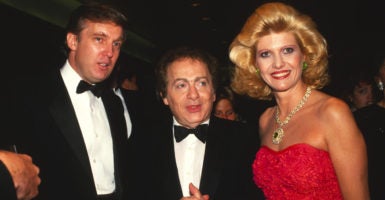President Donald Trump’s upcoming meeting with North Korean dictator Kim Jong Un marks the thawing of a relationship for a president who has marketed himself as the ultimate negotiator.
“For the first time in a long time, the United States is actually having conversations from a position of strength,” @PressSec says
“The president, I think, is the ultimate negotiator and dealmaker when it comes to any kind of conversation,” White House press secretary Sarah Huckabee Sanders said Friday.
The meeting itself is tentatively set for May for a time and place the White House says is still to be determined.
It’s unlikely the U.S. and North Korea will hammer out a nuclear deal at the meeting, said Bruce Klingner, senior research fellow for Northeast Asia at The Heritage Foundation.
“Supporters of the president will say he can use his business acumen to get what he wants, while others will say it’s dangerous to go into this unscripted,” Klingner said.
Trump’s famous 1987 book, “The Art of the Deal,” lays out several points that could be applicable in making a deal with North Korea or other foreign adversaries.
1. Walking Away
In 2011, Trump paraphrased his own book in a tweet.
“Know when to walk away from the table.” The Art of the Deal
— Donald J. Trump (@realDonaldTrump) July 27, 2011
As a candidate, Trump strongly criticized President Barack Obama’s administration for too eagerly seeking a nuclear deal with Iran. Many Republicans accused the Obama administration of wanting a deal too much and thus being unwilling to walk away.
In 2013, years away from ascending to the White House, Trump tweeted:
“The worst thing you can possibly do in a deal is seem desperate to make it.” – The Art of The Deal.
— Donald J. Trump (@realDonaldTrump) November 25, 2013
2. Flexibility
In 2012, Trump also said flexibility is a key to success while negotiating.
“I also protect myself by being flexible. I never get too attached to one deal or one approach.” – The Art of The Deal
— Donald J. Trump (@realDonaldTrump) December 18, 2012
Too much flexibility poses risks, Klingner said, citing how agreeable Trump was in meetings with members of Congress about immigration, as well as Trump’s spring 2017 meeting with Chinese President Xi Jinping.
He said the United States must determine a finite set of agenda items before the meeting to ensure it’s more than a photo opportunity that would only elevate Kim.
“It is a very short deadline and the administration has a very thin bench of expertise on Korea,” Klingner told The Daily Signal. “This is a very high-risk gamble. Perhaps it will be successful, but there will be a lot of nervous people outside the room.”
The White House and South Korea said in public statements Thursday that the North Korean government is willing to denuclearize and will suspend missile testing. It has also dropped its longstanding objections to U.S.-South Korean military exercises.
“The understanding, the message from the South Korean delegation, is they would denuclearize,” Sanders told reporters Friday. “That is what our ultimate goal has always been and that will have to be part of the actions we see them take. We have to see concrete and verifiable actions take place.”
3. Leverage
Trump spoke with Xi of China on Friday, according to a readout from the White House, which said: “The two leaders welcomed the prospect of dialogue between the United States and North Korea, and committed to maintain pressure and sanctions until North Korea takes tangible steps toward complete, verifiable, and irreversible denuclearization.”
Sanders said the president’s policies of increased sanctions and further support from allies has led to North Korea seeking the meeting.
“This maximum pressure campaign and this process has been ongoing since the president first took office,” Sanders said. “For the first time in a long time, the United States is actually having conversations from a position of strength, not a position of weakness, like the one North Korea finds itself in, due to the maximum pressure campaign.”
Citing his book in 2012, Trump tweeted:
“The best thing you can do is deal from strength, and leverage is the biggest strength you have.” – THE ART OF THE DEAL
— Donald J. Trump (@realDonaldTrump) November 27, 2012
A month later, the future president tweeted:
“Leverage: don’t make deals without it.” – The Art of The Deal
— Donald J. Trump (@realDonaldTrump) December 28, 2012
4. Confrontation
The announced meeting comes less than a year after the leaders appeared to threaten each other with a nuclear attack.
As Trump reminded his Twitter followers in 2012, his first book says:
“Much as it pays to emphasize the positive, there are times when the only choice is confrontation.” – The Art of the Deal
— Donald J. Trump (@realDonaldTrump) November 16, 2012
Months ago, the president talked about “fire and fury” and called Kim “Little Rocket Man.”
“The Art of the Deal” says: “Sometimes, part of making a deal is denigrating your competition.”
If he is consistent with the book, the president will anticipate the possibility of a negative outcome of the conference, as “The Art of the Deal” says: “I always go into the deal anticipating the worst. If you plan for the worst—if you can live with the worst—the good will always take care of itself.”































